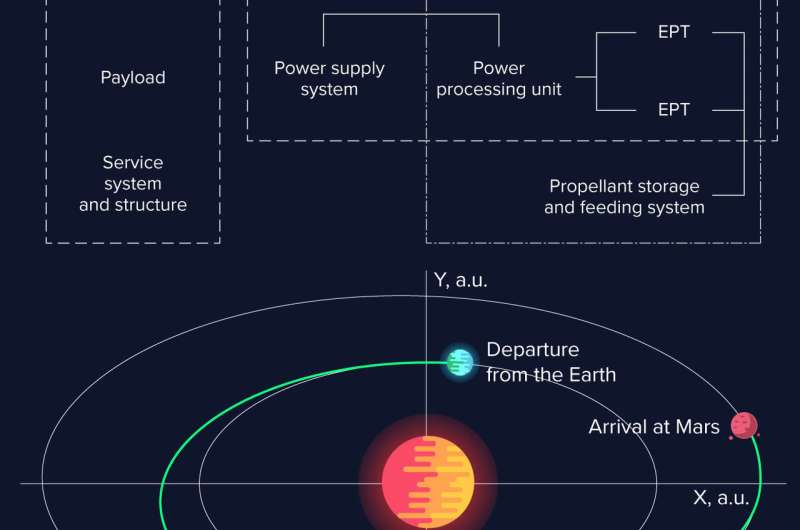Researcher calculates optimal trajectories to Mars and Mercury for a spacecraft with electric propulsion

RUDN University mathematician has proposed a method for calculating the optimal trajectory of spacecraft with electric propulsion, whose thrust is thousands times less than chemical one has, but it is able to work for years. These motors are best suited for interplanetary missions. Mathematicians calculated the flight parameters of the space probe with such motor to Mars and Mercury. The paper is published in the journal Cosmic Research.
Chemical rocket engines create a large thrust, which allows bringing tons of cargo in orbit for a few minutes. At the same time, a huge amount of fuel is consumed. Once the spacecraft is in outer space, a large thrust becomes unnecessary, especially for automatic interplanetary stations that can fly to their destination for years.
An electric propulsion system (EPS) is better suited for such missions. The propellant in an electric propulsion system is ionized gas, which is accelerated in a magnetic field. Due to the low consumption of the propellant, the EPS is able to work for a very long time.
"Because of the low thrust levels of EPS, it can be used most effectively only at sufficiently large distances from the attracting objects (planets or massive moons), i.e., in interplanetary flights," mathematician Alexey Ivanyukhin explains.
According to him, in the case of the use of EPS in the vicinity of a massive body, the available jet acceleration can be extremely low in relation to the gravitational acceleration—at the level of 10−5-10−4. But on interplanetary trajectories, the level of jet acceleration of the EPS is not much inferior to the sun's gravity, and their ratio can be 10−2-10−1.
Alexey Ivanyukhin reminded that for the exploration of the solar system at the turn of the century EPS have been used as primary propulsion system. The first such spacecrafts were Deep Space 1 (an asteroid and two comets fly-by), Smart-1 (lunar orbit insertion), Hayabusa (delivery of soil samples from the asteroid Itokawa), Dawn (consecutive flight to the asteroids Vesta and Ceres).
RUDN University mathematicians have solved the problem of trajectory optimization for spacecraft with EPS. They determined the maximum possible useful spacecraft mass and optimum characteristics of the propulsion system, the most suitable for each of the considered missions.
An enlarged model of spacecraft systems and specific characteristics reflecting the current level of technology (for example, the ratio of the solar panel mass to electric power) were used to determine these parameters.
The researchers considered missions to Mars and Mercury. Calculations have shown that the space probe with EPS and with the specified characteristics will be able to reach Mars in 350 days at the start date of April 30, 2035. The transfer to Mercury will take about 3000 days.
Besides, mathematicians have shown that for a wide class of trajectories, the maximum value of useful spacecraft mass is achieved on the trajectory with the constantly running engine, that is, with the minimum possible thrust necessary for the flight.
"This suggests that the increase in thrust, which will reduce fuel costs, is ineffective in comparison with the increase in the required mass of the propulsion system itself. This is due to the main problem of space exploration—the lack of compact and powerful energy sources," Alexey Ivanyukhin explains.
He and his colleagues are planning to continue research in this direction.
"For example, we intend to consider missions to asteroids to deliver soil or flights to the moon. It is possible to consider a more detailed model of operation of the EPS or solar panels. Developers of EPS and spacecrafts are interested in such studies," Alexey Ivanyukhin concludes.
More information: V. G. Petukhov et al. Joint Optimization of Control and Main Trajectory and Design Parameters of an Interplanetary Spacecraft with an Electric Propulsion System, Cosmic Research (2019). DOI: 10.1134/S0010952519030079
Provided by RUDN University





















